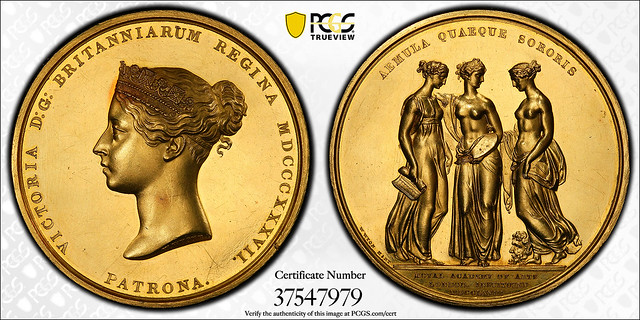
PREV ARTICLE
NEXT ARTICLE
FULL ISSUE
PREV FULL ISSUE
EDWARD RUMSEY ROYAL ACADEMY OF ARTS GOLD MEDALAn article by Jay Turner published November 14, 2019 on the PCGS web site discusses a rare gold medal issued by the Royal Academy of Arts. -Editor

While Rumsey did have a long and successful architectural career, with impressive buildings to his credit, the accolade for which he was most famous, the Gold Medal from the Royal Academy of Arts, was from architectural drawings for a cathedral that was never constructed. Rumsey received his architectural training by studying under the great 19th-century English architect Gilbert Scott. In 1847 at the age of 23, Rumsey submitted drawings for a Gothic cathedral to the Royal Academy of Arts that were deemed so excellent that he was awarded the Academy's Gold Medal. But even with this prestigious prize and acclaim that went with it, Rumsey found little professional success. He decided to move to Australia in hope that there would be more opportunity to earn commissions for his work. In 1861, gold was discovered in Otago in the Southern Island of New Zealand, touching off a gold rush that drew miners from as far away as California. Rumsey was one of the many Australians who would pull up stakes and head for the gold fields of this island colony. Rumsey settled in the city of Dunedin. Soon thereafter, Rumsey submitted a design for the Government House which was to be constructed in New Zealand's largest city, Auckland. Rumsey won an award for his design but, like his design for the Gothic cathedral in England, that never came to fruition. So, too, did his submission for the Government House fail, and someone else received the work. The Gold Medal from the Royal Academy was the only such medal awarded in 1847. The medal, designed by W. Wyon and dated 1837, was struck at the Royal Mint and features a bust of Queen Victoria. The reverse features the three graces of architecture, painting, and sculpture. The medal is referenced today in British Historical Medals as BHM-1795 and in Eimer as E-13068. The medal weighs 120.13 grams, and its precious metal value represented a significant amount of money in 1847 as it is today. Given that, it is amazing the medal still exists today.
To read the complete article, see:
Wayne Homren, Editor The Numismatic Bibliomania Society is a non-profit organization promoting numismatic literature. See our web site at coinbooks.org. To submit items for publication in The E-Sylum, write to the Editor at this address: whomren@gmail.com To subscribe go to: https://my.binhost.com/lists/listinfo/esylum All Rights Reserved. NBS Home Page Contact the NBS webmaster 
|